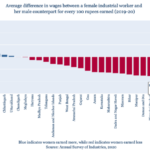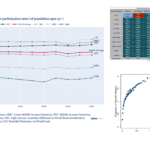The contractualisation of workforce in India’s factories continues
The share of contract workers in India’s formal manufacturing workforce has grown from 23.1 percent in 2002-03 to 40.2 percent in 2021-22
Key highlights:
- The total number of workers in the formal manufacturing sector in India has increased from 6.1 million in 2002-03 to 13.6 million in 2021-22
- Among them, the share of workers directly employed by factories was 59.8 percent while the other 40.2 percent were contract workers
- The share of contract workers has been on the rise – from 23.1 percent in 2002-03, the share had gone up to 40.2 percent in 2021-22
- Factories in rural areas have a higher share of contract workers than those in urban areas
- Among states, Tripura had the highest share of contract workers (85.8 percent) whereas Arunachal Pradesh had the least share of contract workers (9.7 percent) in 2021-22
More than 13 million workers were employed in India’s formal manufacturing sector as of 2021-22, data from the Annual Survey of Industries (ASI) shows. Of this, 8.1 million were directly employed by factories while another 5.5 million were hired as “contract workers”.
The annual survey of industries is conducted by the National Sample Survey Organisation (NSSO) annually and is the main source of industrial statistics in India. The two volume ASI report provides detailed results of the formal manufacturing sector in the country.
In an earlier analysis, CEDA had reported that an increasing number of workers working in India’s factories are now contract workers. This was based on an analysis of ASI data from 2001-02 to 2017-18. During this period, the absolute number of workers in India’s formal manufacturing industry had increased from 5.96 million in 2001-02 to 12.2 million in 2017-18. But in the same period, the share of workers who were directly employed by factories had gone down from 78.2 percent to 63.6 percent, while contract workers’ share had increased from 21.8 percent to 36.4 percent, CEDA had found.
In this analysis, we look at how these trends have evolved in the last 20 years, from 2002-03 to 2021-22.
Growth in the number of factories and floor workers in the formal manufacturing sector
The number of operational factory units in India has increased by 43 percent from 1,40,748 in 2002-03 to 2,00,576 in 2021-22.
In the same period, the number of workers employed in India’s factories has more than doubled from 6.1 million in 2002-03 to 13.6 million in 2021-22, However, this growth has been uneven. During 2003-04, the workforce shrank by over six percent as compared to a year ago. It grew in subsequent years, but in 2012-13, the total number of workers fell four percent as compared to 2011-12. During 2020-21 (the first wave of Covid-19 pandemic), the workforce in this sector shrank by 3.6 percent. In the following year, the total workforce expanded by 8.1 percent to 13.6 million in 2021-22, the latest year for which ASI data is available.
The number of contract workers continues to grow
As CEDA has noted previously, there has been higher growth in the number and share of contract workers within the industrial workforce since the turn of the millennium. Between 2002-03 and 2021-22, the number of directly employed workers increased from 4.7 million to 8.1 million, while the number of contract workers grew from 1.4 million to 5.5a million, a growth of 72.3 percent and 292.9 percent respectively.
This has led to a change in the composition of the workforce. In 2002-03, 76.9 percent of workers were directly employed by factories and the rest 23.1 percent were contractual workers. By 2021-22, the share of directly employed workers had decreased to 59.8 percent and the share of contract workers had increased to 40.2 percent.
The numbers indicate that Indian firms are increasing their reliance on contract workers for factory units. Contractual workers are not directly employed by the firms but are hired on a contractual basis, often through third-party agencies. This shift could be due to various factors, including the need for greater flexibility in workforce management, cost considerations, and the evolving nature of employment practices in the manufacturing sector. Contract workers are not covered by the same employment benefits and protections as permanent workers, such as job security, health insurance, and paid leave, thereby making their employment more precarious.
Factories in rural areas employ a higher proportion of contract workers
Factories located in rural areas are likely to have a higher share of contract workers than their urban counterparts (Figure 4). In 2002-03, the share of contract workers in factories located in both rural and urban areas had a similar share of contract workers (about 23 percent) but thereafter, the gap between the two started increasing with an increase in their absolute numbers. In 2021-22, 43.5 percent of workers in rural areas were contractual, up from 23.2 percent in 2002-03, while in urban areas, contract workers comprised 37.5 percent of all workers in 2021-22 (up from 23.1 percent in 2002-03).
Certain sectors have higher shares of contractual workers
The share of contract workers varies widely across different industries (Figure 5). The coke, refined petroleum and nuclear fuel industry has the highest share of contract workers – three in every four workers (74.6 percent) was a contract worker in 2021-22, in this industry. Other industries with a higher share of contract workers include the non-metallic mineral industry, transport equipment industry, and electrical and optical equipment industry. In contrast, the textiles, textile products, and leather and footwear industry has the highest share of directly employed permanent workers and the lowest share of contract workers, at just 16.8 percent. The wood and cork industry, paper and pulp industry, and manufacturing and recycling industry also have lower shares of contract workers and a higher share of directly employed workers in their workforce.
The share of contract workers has increased for most industries as compared to 2002-03, except for the paper and pulp industry and textile industry. Coke, refined petroleum and nuclear fuel industry has witnessed the highest increase in the share of contract workers, 58.1 percentage points. This was followed by other metallic mineral industries and basic metals and other fabricated metal products industries. In a working paper from 2019, Radhicka Kapoor and P.P. Krishnapriya note similar trends and observe that capital intensive industries have seen a greater increase in contract worker intensity. This is despite the fact that such industries need relatively more skilled workers as compared to labour intensive ones, and speculate that there may be other factors driving contractualisation beyond just labour regulations.
There is wide variation in the composition of the industrial workforce across states
In 2021-22, Tripura had the highest share of contract workers, 85.8 percent, whereas Arunachal Pradesh had just 9.7 percent of contract workers among the total workers. States with higher share of contract workers are Bihar (68.6 percent), Telangana (64.9 percent), Meghalaya (62 percent), Goa (61.7 percent) and Odisha (58.4 percent). While states like Manipur (11.5 percent), Kerala (21.4 percent), Tamil Nadu (23.1 percent), and Punjab (30.6 percent) were among those which had comparatively lower shares of contract workers in the formal manufacturing sector (Figure 6b).
The share of contract workers across states have witnessed an increase in the last twenty years. But this increase in the share of contract workers is not uniform across the states. Jharkhand witnessed the highest increase of 40 percentage points from 15 percent in 2002-03 to 55 percent in 2021-22. It is followed by states like Maharashtra, 31 percentage point increase from 22 percent to 53 percent and Uttarakhand, 30 percentage point increase from 24 percent to 54 percent.
Some of these trends could be a function of the industrial composition in the states. Further, Sanjay Upadhyay (2017) of the V. V .Giri National Labour Institute examined the impact of amendments in the Contract Labour (Regulation & Abolition) Act across different states and noted that these amendments eased the regulations required for those employing 50 or more contract workers. The study also recorded comments from trade unions who argue that the amendments have virtually universalized contract labour and the provision relating to the contract labour board has been dispensed with. Another study by Deb Kusum Das, Homagni Choudhury and Jaivir Singh (2015) argues that the pro-employer judgments on contract labour act in the post-liberalisation years have resulted in an increase in the share of contract labourers in the total workers.
If you wish to republish this article or use an extract or chart, please read CEDA’s republishing guidelines.




